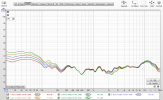Hi
Audyssey is probably run by a bunch of technophiles/technicians aka "nerds" with little understanding of marketing. Audyssey is far better than most people realize. The jury is out, on which is better, Audyssey or Dirac. The knee-jerk reaction is that Dirac "ought" to be better but there hasn't been any conclusive, read, objective, tests to ascertain this. Dynamic EQ is a needed feature, and it works well. Not much effort. You turn it on, it works. Period.
Since we are advancing anecdotes and subjective opinions: I, haven't noticed any particular increase in the surround channels level .. or if there has been , it hasn't bothered me. The reality of the situation is that the Fletcher-Munson curves are not an abstraction, these curves are a very good approximation, of the way most people hearing apparatus works: A system that is calibrated for an average level, let's call it "Reference" for the lack of a more proper term, shall not sound the same or equally well at all level of loudness, especially those below that "reference" level. THe system response must be compensated. So far the best compensation feature, in my book, is that of the Denon/Marantz and other Audyssey-driven AVRs. I find it strange that most other DRC don't have it. It is nil-impossible to always listen at "Reference".. Life constantly requires that you turn the volume up or down and .. there goes your so carefully reference corrections... to your ears... IT has become to me an essential feature. At this point in time I don't see myself moving away from Audyssey unless other DRC provide a similar feature. Not even Trinnov or Storm with all their features would tempt me, The HT-1 if it works without any glitch (not what I tend to think from many reports) would be the Pre/Pro I would consider simply because it has a similar feature... I'll cross this bridge when (and if) I come to it .. For now , Audyssey...
Peace.
Audyssey is probably run by a bunch of technophiles/technicians aka "nerds" with little understanding of marketing. Audyssey is far better than most people realize. The jury is out, on which is better, Audyssey or Dirac. The knee-jerk reaction is that Dirac "ought" to be better but there hasn't been any conclusive, read, objective, tests to ascertain this. Dynamic EQ is a needed feature, and it works well. Not much effort. You turn it on, it works. Period.
Since we are advancing anecdotes and subjective opinions: I, haven't noticed any particular increase in the surround channels level .. or if there has been , it hasn't bothered me. The reality of the situation is that the Fletcher-Munson curves are not an abstraction, these curves are a very good approximation, of the way most people hearing apparatus works: A system that is calibrated for an average level, let's call it "Reference" for the lack of a more proper term, shall not sound the same or equally well at all level of loudness, especially those below that "reference" level. THe system response must be compensated. So far the best compensation feature, in my book, is that of the Denon/Marantz and other Audyssey-driven AVRs. I find it strange that most other DRC don't have it. It is nil-impossible to always listen at "Reference".. Life constantly requires that you turn the volume up or down and .. there goes your so carefully reference corrections... to your ears... IT has become to me an essential feature. At this point in time I don't see myself moving away from Audyssey unless other DRC provide a similar feature. Not even Trinnov or Storm with all their features would tempt me, The HT-1 if it works without any glitch (not what I tend to think from many reports) would be the Pre/Pro I would consider simply because it has a similar feature... I'll cross this bridge when (and if) I come to it .. For now , Audyssey...
Peace.
